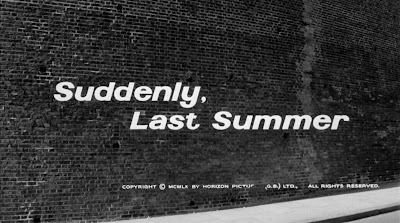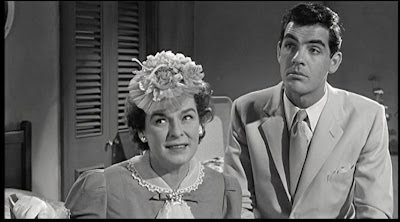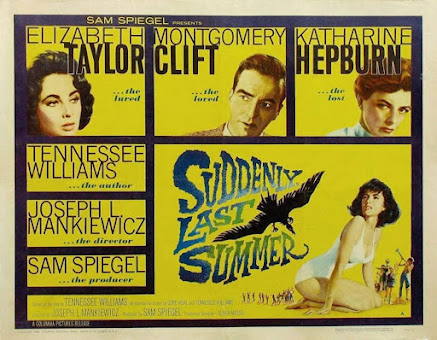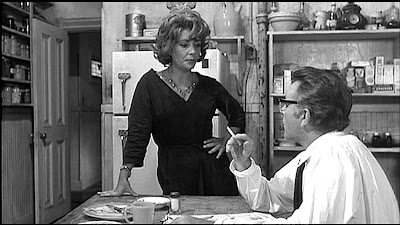Late in the summer of 1973, just around the time I and most
of America were in the throes of a pop-cultural mania sparked by the powerhouse
release of The Exorcist, the
delectably tense drawing-room thriller Night Watch was sneaked into Bay Area theaters without benefit of fanfare or
much in the way of advance publicity.
This was at the height of Elizabeth Taylor’s and Richard
Burton’s waning relevance as both movie stars and tabloid darlings, theirs having
been a ten-year reign of bad publicity, bad behavior, and bad films together —the sublime Who’s Afraid of Virginia Woolf? notwithstanding—culminating in a final tandem screen appearance in the 1973 two-part TV movie “Special Event” prophetically titled Divorce His – Divorce Hers (their 10-year marriage would end the following year). Like most everyone else at the time, I had grown pretty
tired of hearing about the ubiquitous “Liz & Dick”—Hollywood’s answer to Orthrus, the mythological
two-headed beast—whose conspicuous private life excesses had long overshadowed
any merit I once accorded their professional talents. Off my personal radar for
some time, I hadn't seen Elizabeth Taylor in a movie since 1968’s Secret Ceremony (which I loved), but
when I saw the newspaper ad for Night
Watch, I knew I HAD to see this movie.
Based on playwright Lucille Fletcher’s (Sorry, Wrong Number) moderately successful 1972 Broadway play starring Joan Hackett and future Taylor co-star Len Cariou ( A Little Night Music - 1977), Night Watch, on the surface, treads territory familiar to those acquainted with George Cukor’s Gaslight (1944) or any of those “Is she crazy or is she being driven crazy?” thrillers like Midnight Lace (1960), Diabolique (1955), and Sudden Fear (1952).
Based on playwright Lucille Fletcher’s (Sorry, Wrong Number) moderately successful 1972 Broadway play starring Joan Hackett and future Taylor co-star Len Cariou ( A Little Night Music - 1977), Night Watch, on the surface, treads territory familiar to those acquainted with George Cukor’s Gaslight (1944) or any of those “Is she crazy or is she being driven crazy?” thrillers like Midnight Lace (1960), Diabolique (1955), and Sudden Fear (1952).
Idle and wealthy Ellen Wheeler (Taylor), the neglected wife
of loving but desperate-to-prove-he’s-not-living-off-her, workaholic husband, John
(Harvey), is still, after eight years, haunted by memories of her first
husband’s death: a violent automobile crash that also took the life of his 20-year-old
mistress. After suffering a crippling breakdown, Ellen has since been plagued by
nightly bouts of insomnia and subtly treated as a mentally fragile time-bomb by
both her husband and her visiting girlhood friend, Sarah (Whitelaw).
On one particularly stormy night vigil, with too little sleep
and too many inner demons to battle (and there are a LOT of rainstorms in this
London-based thriller), Ellen glances out the window to the abandoned house
across the courtyard and sees, in a flash of lightning and flurry of
storm-tossed shutters, the horrifying image of a man with a slashed throat
propped grotesquely in a wing-back chair situated close to the window. When a police search of the old dark house fails to unearth
even a trace of habitation, let alone evidence of foul play, John and Sarah’s concern
for Ellen’s mental state intensifies. Meanwhile, Ellen herself grows increasingly convinced that what she saw was real.
I don’t tend to think of myself as someone drawn to a particular type of film, but truth be told, I confess to having a decided weakness for suspense thrillers. Unfortunately, the flip side of being a film fan any length of time is a growing over-familiarity with certain narrative tropes and plot devices. A too-steady diet of suspense thrillers can wreak havoc with the ability to find a film you can't second guess or stay one step ahead of. As movie genres go, the suspense thriller (and its attendant sub-categories: the psychological thriller, the mystery, the whodunit, the erotic thriller, the sci-fi chiller) is one of the last strongholds of cinema amazement. Thus I really relish it when, as is the case of Night Watch, a movie so narratively conventional on the surface can still have so many sinister surprises up its sleeve.
WHAT I LOVE ABOUT THIS FILM
PERFORMANCES
Reunited with her Butterfield 8 co-star, Laurence Harvey (only 45 years old at the time but exhibiting the wasting effects of the stomach cancer that would take his life only four months after the film’s release), Taylor is simply terrific as the high-strung witness to a possible murder no one believes really happened. Like late-career Bette Davis and Joan Crawford, late-career Elizabeth Taylor is often a matter of taste. Those having a problem with her impossible-to-ignore star persona, fluctuating weight gain (sometimes mid-film), designer caftans, and unique vocal style (she’ll insert pauses and stress emphasis in the most unexpected places) are not likely to be persuaded by her work here. Me, I think she’s the tops, and in Night Watch she gives a spellbindingly intense performance that's revealed to be even sharper and subtler upon repeat viewings.
THE STUFF OF FANTASY
For those uninterested in taking either Elizabeth Taylor or the film seriously, Night Watch has much to recommend it in camp appeal for the terrifically glossy '70s look of the whole thing. There's Taylor at her 1973 diva best, photographed flatteringly and sporting a host of conceal/reveal '70s finery. There is much to take in visually, from big hairstyles, glam makeup, bulky jewelry, turtlenecks, positively enormous sideburns, wide ties, and even an ascot.
Though rarely referenced and seen by very few, Night Watch is one of my favorite thrillers. I'd recommend it to anyone with a fondness for the magnificent Elizabeth Taylor, or for anyone interested in atypical curios from this favored actress's career.
Happily, the Warners Archive Collection DVD has been beautifully remastered and is a huge improvement over the exceedingly dark, pan-and-scan VHS release from several years back. Scenes once taking place in near-total darkness (those who've seen the film know what I mean) are startlingly clear. Also, and I might be misremembering here, but I thought there was once a terrible George Barrie / Sammy Cahn theme song played over the end credits that has since been removed (hooray!). I see the song exists in the IMDB credits (title: "The Night Has Many Eyes") and I seem to recall it being sung by a Tom Jones sound-alike. In any event, my recollection of it was that it was 100% not the kind of MOR Sinatra-esque ditty you wanted to be played after the jolting finale of this thriller. It reminds me of Henry Mancini's equally mood-killing and inappropriate "love theme" from Wait Until Dark.
I don’t tend to think of myself as someone drawn to a particular type of film, but truth be told, I confess to having a decided weakness for suspense thrillers. Unfortunately, the flip side of being a film fan any length of time is a growing over-familiarity with certain narrative tropes and plot devices. A too-steady diet of suspense thrillers can wreak havoc with the ability to find a film you can't second guess or stay one step ahead of. As movie genres go, the suspense thriller (and its attendant sub-categories: the psychological thriller, the mystery, the whodunit, the erotic thriller, the sci-fi chiller) is one of the last strongholds of cinema amazement. Thus I really relish it when, as is the case of Night Watch, a movie so narratively conventional on the surface can still have so many sinister surprises up its sleeve.
 |
| "That's what the watchers of the night are for. Things that in daytime are unknown and unremembered." |
WHAT I LOVE ABOUT THIS FILM
As a lifelong insomniac familiar with the kind of subtle
disquiet that can creep into the soul in the wee small hours of the morning, I
have to say first and foremost I love the film’s title. To “Night Watch” is a perfect
description of what it feels like to be wide awake when the vast majority of
those around you are asleep. It feels like you’re standing metaphysical guard against your
id playing havoc with all those subterranean thoughts and repressed terrors your
ego holds so reliably in check during the daylight hours. Secondly, I found myself totally caught up in the way Night Watch uses the conventions of the Modern Gothic to construct a persuasively suspense-filled thriller built around
the uncertainty of perception. This film is full of games of truth and illusion more deceptive (and far deadlier) than any of those employed by
Albee’s George and Martha.
 |
| "If the mind is obsessed enough with something it can actually produce an image on the retina. It has a name...it's called an 'eidetic image'." |
PERFORMANCES
With but a few exceptions, most of my favorite actresses
have tried their hand at the suspense thriller. Meryl Streep – Still of the Night; Audrey Hepburn – Wait Until Dark; Sandy Dennis – That Cold Day in the Park; Julie
Christie – Don't Look Now; Jane Fonda – Klute; Lauren Bacall – The Fan; Susannah York – Images; Faye Dunaway - Eyes of Laura Mars; …even such unlikely
candidates as Goldie Hawn (Deceived)
and Twiggy (W). In this, her sole
foray into the world of scream queens, daggers, and red herrings, Elizabeth Taylor is to
the manner born.
Movies like this tend to fall apart if the audience is unable to identify with or relate to a character's dilemma. Elizabeth Taylor, an actress of fragile appearance masking a steely core, brings a considerable amount of verisimilitude to her character, making Ellen's deteriorating mental state both believable and compelling. She is given solid support by the talented, exclusively British, cast, but Taylor holds the whole thing together by making her terror seem debilitatingly real. Perhaps this is due to Taylor, an actress who has played characters created by Tennessee Williams,
Edward Albee, and Carson McCullers; not being an individual we consider to be a stranger
to hysterics.
 |
| Cracking Up |
Reunited with her Butterfield 8 co-star, Laurence Harvey (only 45 years old at the time but exhibiting the wasting effects of the stomach cancer that would take his life only four months after the film’s release), Taylor is simply terrific as the high-strung witness to a possible murder no one believes really happened. Like late-career Bette Davis and Joan Crawford, late-career Elizabeth Taylor is often a matter of taste. Those having a problem with her impossible-to-ignore star persona, fluctuating weight gain (sometimes mid-film), designer caftans, and unique vocal style (she’ll insert pauses and stress emphasis in the most unexpected places) are not likely to be persuaded by her work here. Me, I think she’s the tops, and in Night Watch she gives a spellbindingly intense performance that's revealed to be even sharper and subtler upon repeat viewings.
 |
| The icy reserve of Billie Whitelaw (who would later terrify as the menacing nanny, Mrs. Baylock, in The Omen) contrasts effectively with Taylor's more earthy vulnerability. |
 |
| Suspiciously conciliatory neighbor Mr. Appleby (Robert Lang) directs Ellen's attention to something in the window of the abandoned house next door. |
THE STUFF OF FANTASY
At first glance, Night
Watch looks like a derivative catalog of hoary horror film clichés. And,
well…it is. There’s the woman in distress; the incessant thunderstorms with
well-timed lightning flashes; the old dark house; the ludicrously skeptical
friends and annoyingly unhelpful police; the red herring assortment of suspicious characters
with dubious motives; the non-stop entreaties to “calm down” or “get some sleep” - they’re all there.
It’s only later, when you start to realize how much your
expectations have been intentionally manipulated, does it begin to sink in how
cleverly Night Watch works audience
familiarity with the conventions of the genre to it its advantage. It's a tight, well-paced thriller that deftly builds its suspense by playing with the audience's mind as cleverly as it plays with that of Taylor's character.
 |
| Bill Dean as Inspector Walker |
THE STUFF OF DREAMS
I was 15 years old when I saw Night Watch, and even after the nerve-wracking horror of The Exorcist, the PG-rated Night Watch
scared the hell out of me. Seeing it now some 30 years later, not only does it
really hold up as a crackerjack thriller that plays fair with its
surprises and twists (it’s one of those rare thrillers – like Hitchcock’s – that
keeps paying dividends the more you see it), but there’s the added bonus of the
whole '70s feel of it.
 |
| La Liz, not having an easy go of it |
For those uninterested in taking either Elizabeth Taylor or the film seriously, Night Watch has much to recommend it in camp appeal for the terrifically glossy '70s look of the whole thing. There's Taylor at her 1973 diva best, photographed flatteringly and sporting a host of conceal/reveal '70s finery. There is much to take in visually, from big hairstyles, glam makeup, bulky jewelry, turtlenecks, positively enormous sideburns, wide ties, and even an ascot.
Though rarely referenced and seen by very few, Night Watch is one of my favorite thrillers. I'd recommend it to anyone with a fondness for the magnificent Elizabeth Taylor, or for anyone interested in atypical curios from this favored actress's career.
Happily, the Warners Archive Collection DVD has been beautifully remastered and is a huge improvement over the exceedingly dark, pan-and-scan VHS release from several years back. Scenes once taking place in near-total darkness (those who've seen the film know what I mean) are startlingly clear. Also, and I might be misremembering here, but I thought there was once a terrible George Barrie / Sammy Cahn theme song played over the end credits that has since been removed (hooray!). I see the song exists in the IMDB credits (title: "The Night Has Many Eyes") and I seem to recall it being sung by a Tom Jones sound-alike. In any event, my recollection of it was that it was 100% not the kind of MOR Sinatra-esque ditty you wanted to be played after the jolting finale of this thriller. It reminds me of Henry Mancini's equally mood-killing and inappropriate "love theme" from Wait Until Dark.
 |
| Night Watch reunited Taylor with her Butterfield 8 (1960) co-star, Laurence Harvey. |
Note: I usually try to mix up the kind of films I write about each month, but in looking over my posts for December, I'm pretty sure the preponderance of thriller/suspense films represented this month (Carrie, Eye of the Cat, Night Watch) is in direct response to all that sugary, family-oriented programming one is subjected to on television during the holiday season. However, the highlighting of two Elizabeth Taylor films (A Little Night Music and Night Watch) is without a doubt an attempt on my part to divest myself of the memory of that Lindsay Lohan "Liz & Dick" TV movie which aired on Lifetime last month. Boy, talk about your horror films!
 |
| They cast WHO to portray me? |
A clip from "Night Watch"
Night Watch opened in Los Angeles on
Wednesday, August 22, 1973 at the Pix Theater on Hollywood Blvd.
Copyright © Ken Anderson 2009 - 2012






















































